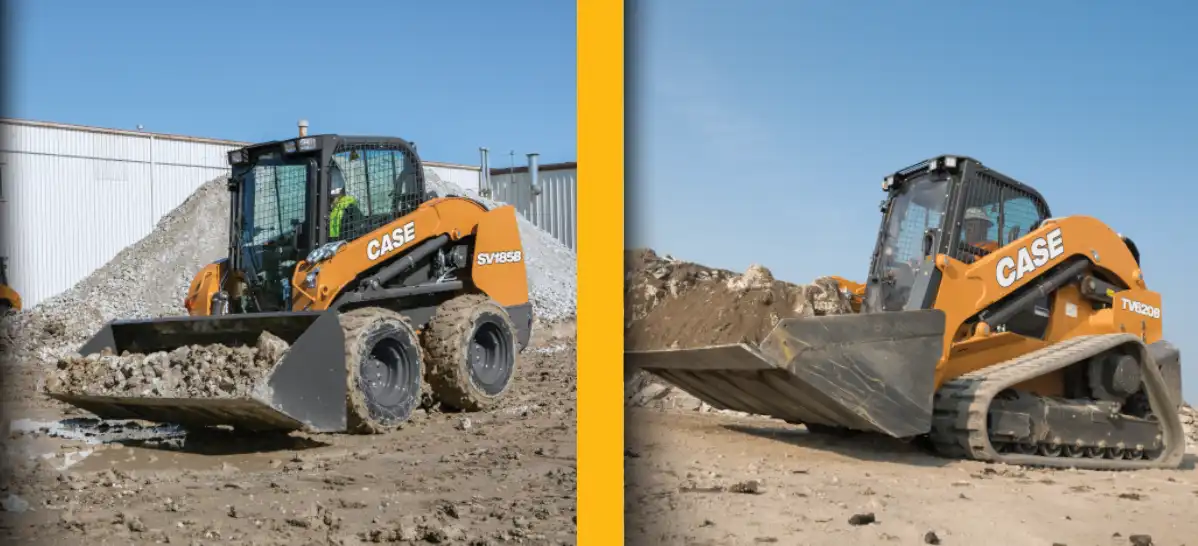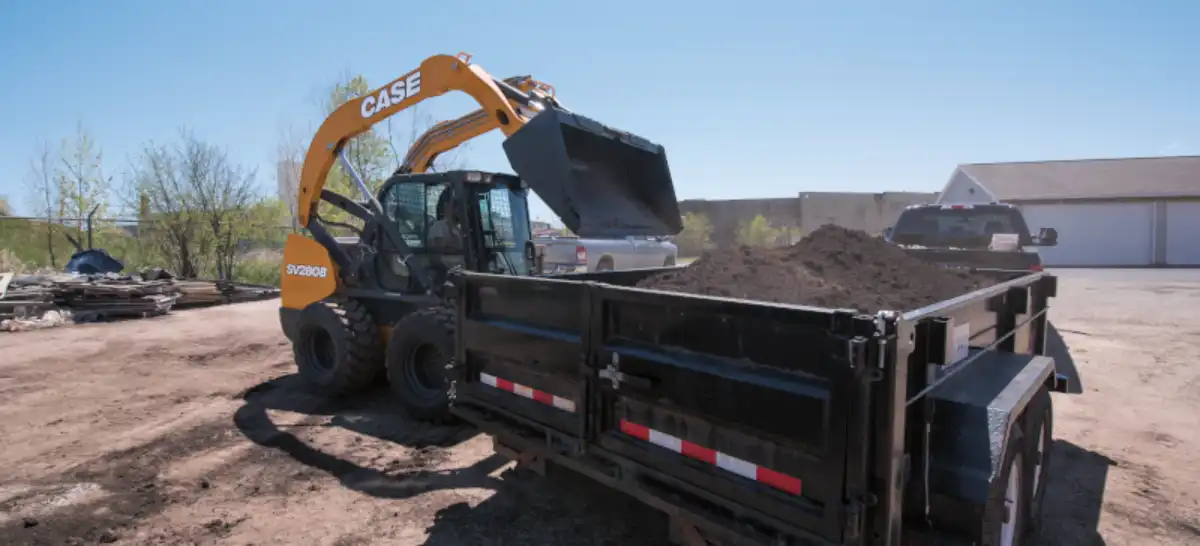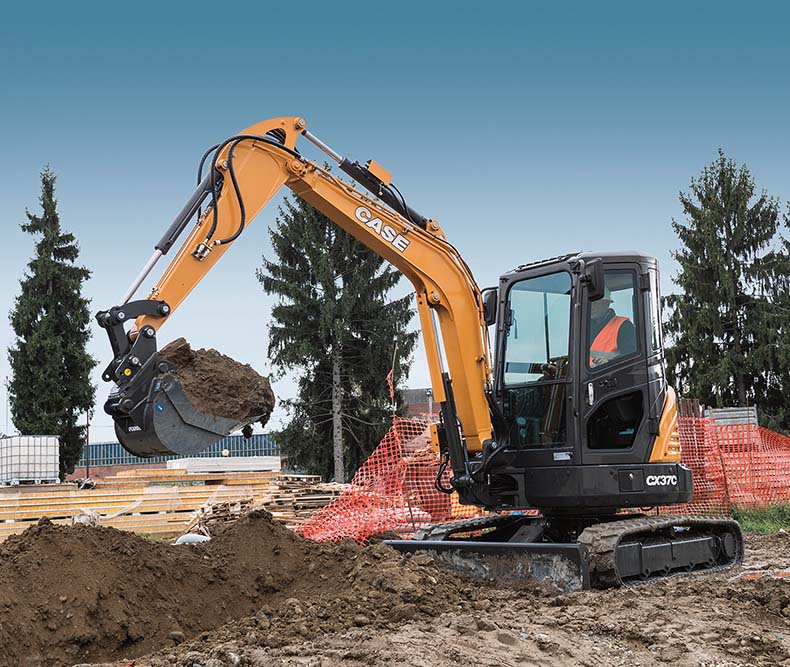
A skid steer or compact track loader may be the most important machine in your fleet – but are you in the right machine?
Whether as support equipment in a larger fleet or the main workhorse for an owner/operator, a skid steer and compact track loader are two of the most versatile machines a contractor can own. But what is the right loader arm and platform for each application? Contractors can follow this quick guide to set them on the right path.
What is a Skid Steer Loader?
A skid steer loader, often simply called a “skid steer” or “skid loader,” is a compact and highly versatile piece of construction equipment. Its defining feature is its rigid frame and fixed-axle wheels, which are locked in synchronization on each side. To turn, the operator increases the speed of the wheels on one side, causing them to skid or drag across the ground, allowing the machine to make zero-radius turns in tight spaces.
This exceptional maneuverability, combined with its ability to use a wide array of hydraulic attachments, makes the skid steer a true job site utility player. From demolition and debris removal to digging, grading, and material handling, its compact size and agility allow it to perform tasks efficiently where larger equipment cannot operate.
What is a Compact Track Loader?
A compact track loader, or CTL, is a versatile earthmoving machine built on a rigid frame with a dedicated track undercarriage instead of wheels. It is engineered to provide exceptional flotation, traction, and stability across soft, muddy, sandy, or uneven terrain where a wheeled machine would struggle.
The key advantage of a CTL lies in its tracks, which distribute the machine’s weight over a large surface area. This results in very low ground pressure, allowing it to “float” over sensitive surfaces like turf with minimal disturbance while also providing a stable, solid platform on challenging slopes and rugged ground. This makes it the ideal machine for landscaping, land clearing, grading, and general construction work in poor underfoot conditions.

Skid Steer vs Compact Track Loader: Key Differences
Loader Arm Types: Radial vs Vertical
One of the most fundamental design choices you’ll make is between a radial and a vertical lift loader arm. Each excels in different areas, and understanding their unique movement paths is key to selecting the right machine for your daily tasks.
Radial Lift
Radial lift machines are the undisputed champions of ground-level work. The loader arms on a radial machine swing outward in a simple arc, a design that gives them superior breakout and prying force. This makes them the ideal choice for heavy digging, grading, and dozing applications.
While their maximum height is lower than a vertical lift, their arc-like path provides excellent forward reach at mid-height. This makes them perfect for tasks like loading and unloading materials from pickup trucks or backfilling against a foundation. Additionally, the simpler arm design often provides better visibility to the sides of the machine.
Vertical Lift
When your primary jobs involve lifting and placing materials at height, a vertical lift machine is the clear choice. Using a more complex linkage, these loader arms raise the load in a nearly straight path. This design allows them to achieve greater lifting heights and offers significantly more reach at the top of the lift cycle.
The design keeps the load closer to the machine’s center of gravity throughout the lift, which contributes to increased stability and often a slightly higher rated operating capacity compared to a similarly sized radial lift model. This makes them the go-to solution for pallet work, loading high-sided trucks, and stacking materials with precision.
Platform Options: Tires vs Tracks
The second important decision you need to make is choosing between a machine with wheels or tracks. This choice fundamentally dictates the terrain and conditions where your machine will excel, so understanding the distinct advantages of each platform is crucial.
Tires (Skid Steers): The Hard-Surface Specialists
The traditional wheeled skid steer is the undisputed champion of improved surfaces like concrete, asphalt, and hard-packed dirt. Its design is tailored for speed, agility, and cost-effectiveness in these environments.
- Performance: On paved or firm ground, tires provide excellent traction and maneuverability. Wheeled machines are faster, with higher top travel speeds, making them ideal for covering larger job sites quickly. They are also perfectly suited for applications that require constant, tight turning.
- Cost-Effectiveness: Skid steers typically have a lower initial purchase price compared to their tracked counterparts. Furthermore, while tires will wear out, they are significantly less expensive to replace than a full track and undercarriage system, leading to a lower long-term operating cost for businesses working primarily on abrasive surfaces.
Tracks (Compact Track Loaders): Masters of All-Terrain
When your work takes you off the pavement, the compact track loader demonstrates its true value. Its tracked undercarriage is engineered for performance in challenging and sensitive environments.
- Performance: The primary advantage of a CTL is its incredibly low ground pressure. By distributing the machine’s weight across a large track footprint, it can “float” over soft, muddy, or sandy ground where a wheeled machine would sink. This also makes it the ideal choice for working on established lawns and delicate turf without causing significant damage.
- Stability: The wide and stable platform created by the tracks provides superior balance and a smoother ride across uneven terrain. This stability enhances operator confidence and improves performance in tasks like grading, dozing, and operating heavy attachments.

How to Choose the Right Machine for Your Job
Once you’ve decided between tracks or tires, the next critical step is to match the machine’s power and performance to your specific workload. Getting this right is the key to maximizing your return on investment. This decision hinges on three foundational specifications: Rated Operating Capacity (ROC), horsepower, and torque. Understanding how these elements work together is essential to selecting a machine that is not just adequate, but truly productive.
Understanding Your Lifting Needs: Capacity, Horsepower, and Torque
For any skid steer or compact track loader, lifting is often its most demanding job and the truest measure of its capability. When evaluating a machine, the most important specification to start with is its ROC, which is 50% of the machine’s tipping load.
Our best advice is to select a machine with an ROC that not only handles your heaviest typical load but also gives you a comfortable margin. If the heaviest pallet you regularly lift is 2,000 pounds, consider a machine with an ROC of 2,200 or even 2,500 pounds. This is especially crucial in applications like hardscaping, where pallets of pavers or retaining wall blocks can easily exceed 3,000 pounds. Investing in that extra capacity now prevents you from being under-equipped as your jobs grow in scale.
Beyond this primary number, however, lies the crucial relationship between horsepower and torque, which defines how the machine feels and performs under load.
Horsepower: The Engine of Productivity
It’s a common misconception that more horsepower allows a machine to lift more weight. In reality, two machines with the same 2,700-pound ROC will lift the exact same maximum load, regardless of horsepower.
So, what does more horsepower actually do? It drives speed and responsiveness. A higher-horsepower engine enables:
- Faster Cycle Times: The machine can lift, dump, and travel more quickly.
- Improved Multitasking: It can more effectively power multiple functions at once, like driving at full speed while operating a demanding hydraulic attachment.
- Reduced Hydraulic Stall: Imagine charging into a pile for a full scoop. A 74-horsepower machine with a 2,700-pound ROC might lag or stall as the engine struggles to power both the drive system and the hydraulics. In the same scenario, a 90-horsepower machine will feel more powerful, pushing through the pile with less hesitation because it can more easily maintain hydraulic pressure and flow.
Torque: The Power to Push Through
If horsepower is about speed, torque is about pure “grunt” or pushing power. Greater torque gives the operator the ability to power through resistance without the engine bogging down. It’s what keeps the wheels or tracks turning when you push into a dense pile of dirt or gravel. This translates directly to more powerful and consistent performance, especially when digging and loading.
Ultimately, the ideal machine has the right balance: the ROC to safely handle the weight, the horsepower to work quickly and multitask efficiently, and the torque to push through the toughest conditions. Understanding how these three elements work together is the key to choosing a machine that is not just capable, but truly productive.
Attachments and Hydraulic: Standard vs High-Flow
A skid steer and compact track loader’s auxiliary hydraulic system provides the hydraulic flow that drives the machine’s attachments. The thing to remember is that not all attachments have the same hydraulic flow requirement. Let’s compare standard and high-flow hydraulic two systems.
Standard-flow Auxiliary Hydraulics
The most common and fundamental hydraulic system on any skid steer or compact track loader is the standard-flow package. Included as a factory-standard feature on all machines, this system is the backbone for powering a wide variety of hydraulic attachments.
Standard-flow hydraulics operate at the same pressure as the machine’s main hydraulic system, typically around 3,000 pounds per square inch (psi). While the exact flow rate can differ between manufacturers and models, it generally falls within a range of 17.5 to 24.2 gallons per minute (gpm).
This level of hydraulic power is perfectly suited for many of the most popular attachments on the market, making it a versatile solution for everyday tasks. Attachments that run efficiently on a standard-flow system include:
- 4-in-1 Buckets
- Hydraulic Hammers
- Augers
- Trenchers
- Grapples
High-flow Auxiliary Hydralics
A high-flow system is the next step up, designed for attachments that need more speed and power to operate effectively. While it maintains the same pressure as a standard system (around 3,000 psi), it significantly boosts the hydraulic fluid flow, delivering 30 to 40 gpm.
This increase in flow is crucial for “production-style” attachments that perform continuous, demanding work. A high-flow system can be ordered from the factory or installed later as a field upgrade. It’s the right choice for powering tools like:
- Cold Planers
- Large Snow Blowers
- Rock Saws
- Small Mulchers and Chipper/Shredders
For the most extreme applications, an enhanced high-flow (or high-pressure) system is available. The game-changer here isn’t just the flow rate—which is similar to a standard high-flow system—but the dramatic increase in operating pressure to 4,000 psi. This combination of high flow and high pressure generates immense hydraulic horsepower.
This system is reserved for the most power-hungry attachments that tackle the toughest jobs. You’ll need this option for equipment such as:
- Large-scale Cold Planers
- Powerful Mulchers capable of clearing dense brush and small trees
- Industrial Rock Saws used in quarry or roadwork operations
Finally, some advanced attachments require more than just raw power; they need to perform multiple hydraulic functions at once. A secondary auxiliary hydraulics system provides an additional, low-flow circuit to handle these complex movements.
This system is essential for attachments that require one hydraulic movement to run the main function while another performs a secondary action. For instance, it allows an operator to:
- Adjust the side-shift on a cold planer or stump grinder while it’s cutting.
- Change the chute direction on a snow blower while it’s throwing snow.
- Operate the down-riggers on a tree spade for stability.
Operator Controls: Mechanical vs Electro-Hydraulic (EH)
An operator’s skill and comfort in the cab are directly linked to job site productivity, and the type of control system plays a pivotal role in this equation. While many seasoned operators are accustomed to traditional mechanical controls, and some companies continue to purchase them due to familiarity, it’s important to understand their impact on the operator. Because they rely on direct mechanical linkages, these systems require more physical effort. The further an operator needs to push or pull the levers, the more they engage their entire upper body, leading to significant fatigue over a long workday.
In contrast, modern Electro-Hydraulic (EH) controls are designed to minimize physical strain and maximize precision. Instead of strenuous upper-body movements, EH systems allow for effortless, fingertip control, similar to the simple wrist action used with a joystick. This dramatic reduction in physical effort means the operator stays fresher and more focused throughout the day.
But the benefits of EH controls go beyond just comfort. Advanced systems, like CASE’s EZ-EH controls, empower operators to customize machine performance to the task at hand. With the ability to choose from pre-set responsiveness settings and instantly switch between ISO and H patterns via a simple rocker switch, operators can tailor the machine’s behavior for everything from aggressive digging to delicate grading.
Furthermore, innovations such as handles with enhanced “feel points” provide more precise feedback, allowing for incredibly fine-tuned movements, like feathering a load with pinpoint accuracy. When combined, these features—reduced fatigue, customizable performance, and precise control—create an environment where operators can work more efficiently and productively, ultimately impacting your bottom line.

Tier 4 Compliance: What You Need to Know
When selecting a skid steer or compact track loader, understanding engine technology is just as important as comparing lift capacity or breakout force. Modern machines must meet Tier 4 Final emission standards set by the Canada Off-Road Compression-Ignition Engine Emission Regulations. These regulations are designed to drastically reduce harmful pollutants like particulate matter and nitrogen oxides (NOx) from diesel engines.
Most Tier 4 Final machines under 74 horsepower feature a hassle-free emissions system — no regeneration cycles, no filter replacements, and no extra fluids required. For larger models around 90 horsepower, the only additional step is topping off the DEF (Diesel Exhaust Fluid). Fortunately, this is simple to incorporate into your regular preventive maintenance routine and daily walkarounds, making compliance straightforward and stress-free.
Buying a New or Used Skid Steer / Track Loader
While there are many features to consider when purchasing a skid steer or compact track loader, the core factors remain the same: radial vs. vertical lift, tires vs. tracks, hydraulic capabilities, and operating capacity. These elements determine the size, design, and overall performance of your machine.
One of the best pieces of advice? Don’t undersize your investment. Choosing a machine with slightly more capacity than your current needs may feel like upselling, but it’s actually smart planning. That extra capability can save you from future rental costs or additional purchases as your projects grow. Think long-term and choose wisely.
Where you buy your machine is just as important as what you buy. At Inland Truck & Equipment, we offer expert guidance, reliable service, and financing options for all your equipment needs. Ready to find the perfect skid steer or compact track loader? Check out our current Skid Steer and Compact Track Loader inventory.
CASE Compact Track Loaders, CASE Skid Steers



